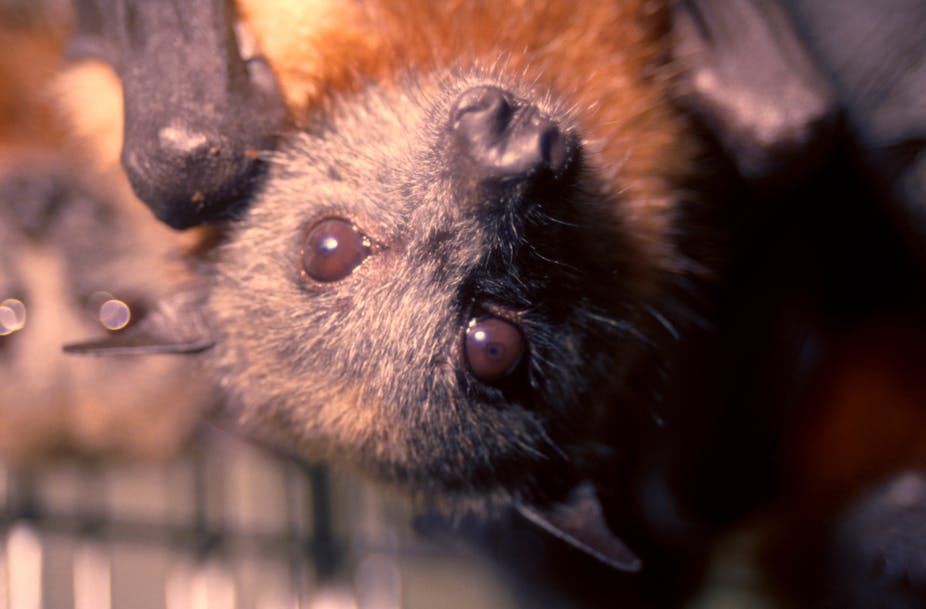In the Chinese zodiac, 2011 is the year of the rabbit but for those of us working on viruses from wildlife animals, it was much more like the year of the bat.
In February, the deadly Nipah virus re-emerged in Bangladesh killing at least 15 people. Nipah virus was first discovered in Malaysia during a large disease outbreak from 1998 to 1999. That outbreak resulted in around 100 human fatalities and more than one million pigs were culled in order to control the spread of the virus.
It’s well known that Nipah is a bat-borne virus, transmitted from bats to pigs, and then from pigs to people. Viruses that have this ability to pass from animals to people are commonly known as zoonotic viruses.
From June to October, Australia experienced its own zoonotic disease threat with 18 properties across Queensland and New South Wales confirming cases of Hendra virus infections. This resulted in the death of 23 horses and, for the first time outside a laboratory setting, Hendra virus antibodies were identified in a dog.

During this worrying time, Queensland Health monitored 68 people for signs of infection due to potential exposure to the virus. Thankfully none of them showed any evidence of this.
In October, a paper published in the journal PLoS Pathogens reported the discovery of a new Ebolavirus-like filovirus in Spanish bats, marking the first detection of this class of killer virus in Europe.
To add a dramatic finishing touch to these real-life events, the release of the Hollywood blockbuster Contagion further drew the world’s attention to the potential damage a novel bat-borne virus could wreak. Although the movie is fictional, it’s a frighteningly realistic depiction of just how fast an infectious disease can take root and spread.
Why bats?
For the last two decades, we’ve witnessed several major disease outbreaks caused by deadly viruses, including Hendra, Nipah, Ebola, Marburg and SARS. All of these viruses originated from bats, yet none seem to cause any clinical disease in the bats, which are known as “reservoir hosts” as carriers of the virus. It appears that bats have a much better symbiotic relationship with viruses than other mammal species.
Recent research findings from different international groups indicate there are numerous viruses circulating among the bat populations around the world. Work on coronavirus – the virus family to which SARS belongs – and paramyxovirus – the family to which human measles and Hendra viruses belong – suggests that all “modern” versions of human and livestock viruses may have a close relative in bats. This has led to the hypothesis that bats could potentially be the “birth place” of most known viruses affecting humans.

Bats are very ancient mammals and have been around for at least 50 or 60 million years. They make a significant contribution to environmental health through their role as essential pollinators and seed dispersers for native forests and they’re the only mammal with true flying ability.
The unique virus-bat relationship is possibly the result of a long history of co-evolution. It may also be the case that the presence of low levels of different viruses in bats may actually have been, and continue to be, advantageous for the bat population.
Research conducted in Australia has demonstrated that although most bat populations show evidence of Hendra virus infection, the level of actively circulating virus is uniformly low. This explains why we’ve generally only experienced one or two events of host switching – from bats to horses – almost every year for the last decade.
But, there were at least 18 incidents of species-jumping for Hendra virus in 2011. This led to the thesis that an increase of Hendra virus in bats or a Hendra virus “spike” are the vital triggers for an outbreak. Research data obtained this year seems to support this hypothesis.
Continuing research
So the $12-million question is what happened in 2011 that’s different from previous years? After the dramatic increase of Hendra cases this year, the Commonwealth and state governments formed the Intergovernmental Hendra Virus Taskforce and provided A$12 million of funding for research into reducing or preventing future outbreaks by answering questions such as this.

As 2011 draws to an end, the story of bat-borne viruses continues. The world continues to change and it’s certain that more and more unknown bat viruses will emerge. The challenge for us is to get ahead of the viruses before they are given the opportunity to jump from one host to another.
The good news is that scientists around the world have already started to work towards developing a system for predicting virus outbreaks, similar to weather and earthquake forecasts, through the Global Virus Forecasting Initiative (GVFi), which is led by Stanford University’s Professor Nathan Wolf.
CSIRO’s “bat pack”, a team of researchers at the Australian Animal Health Laboratory (AAHL) in Geelong, Victoria, is a partner of the GVFi. As the name suggests, the team’s research aims to better understand bat immunology and how bats co-exist with the viruses they carry. Our goal is to identify strategies to control viruses, such as Hendra, from spreading to other animals and people.
Last month, Australia extended its ability to respond to a wide range of continually emerging diseases – that have the potential to harm people, animals and our environment – further with the opening of the world’s most biosecure laboratory.
The new state-of the-art laboratory is located within the high containment facility of AAHL and will provide researchers, such as members of the “bat pack”, with the biosecure and safe infrastructure required to undertake vital research to effectively tackle increasing biosecurity threats, both here and around the world.

